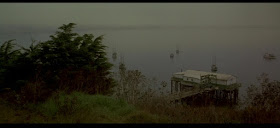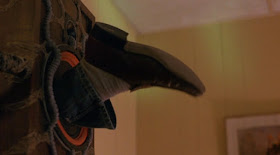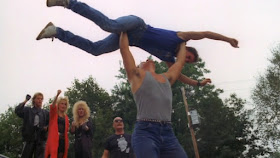
Stars: 4 of 5.
Running Time: 99 minutes.
Tag-line: "Beware the children."
Notable
Cast or Crew: Christopher Reeve (SUPERMAN, SOMEWHERE IN TIME), Kirstie Alley (CHEERS, STAR TREK II: THE WRATH OF KHAN), Linda Kozlowski (CROCODILE DUNDEE, CROCODILE DUNDEE II), Michael Paré (STREETS OF FIRE, EDDIE AND THE CRUISERS, THE PHILADELPHIA EXPERIMENT), Mark Hamill (CORVETTE SUMMER, BODY BAGS, STAR WARS), Peter Jason (THEY LIVE, MORTAL KOMBAT, 48 HRS., DEADWOOD), George "Buck" Flower (BACK TO THE FUTURE, THE FOG). Music by John Carpenter and Dave Davies (of "The Kinks"). Cinematography by Gary B. Kibbe (THEY LIVE, IN THE MOUTH OF MADNESS, BODY BAGS). Screenplay by David Himmelstein (POWER, BAD COMPANY), based on the novel by John Wyndham (DAY OF THE TRIFFIDS, THE KRAKEN WAKES).
Best One-liner: "Well, ain't ya gonna do somethin', or ya just gonna cry like all the other little pissants? Well do
somethin', goddammit!"
VILLAGE OF THE DAMNED '95 has a less than stellar reputation, and, sure, it feels a little more like a feature length X-FILES episode than a Carpenter film,

and yeah, Kirstie Alley doesn't make for the best "Cigarette-Smoking Man,"

and maybe there's some dodgy CGI,

 Or is that CG-eye?
Or is that CG-eye?
and on the poster, the children's faces are weirdly compressed like the graphic designer was trying out Photoshop for the first time, and the best pull quote on the back cover seems to be "One scarifying trip!" from the
New York Times. Despite all of this, I really stand by VILLAGE OF THE DAMNED; it's an effective thriller, and while it's not as memorable as the gloomy, psychotic fantasia of IN THE MOUTH OF MADNESS which Carpy directed the previous year, it's deeply atmospheric, often suspenseful, and occasionally fun. I reject the claims that it doesn't "feel" like a Carpenter film––and in fact would like to take a moment to judge a few elements of VILLAGE OF THE DAMNED in context of the greater Carpenter oeuvre.
#1. The ambiance. Atmospherically speaking, it's incredibly solid. Shot mainly in Point Reyes and Inverness, California––the same locale as
THE FOG––we have plenty of seaside beauty, melancholy landscapes,



and a warm, almost Norman Rockwell-by-way-of-Stephen King vibe.



For me, the "likability" of the community in a piece like VILLAGE OF THE DAMNED is paramount, and Carpenter establishes his "Midwich" as a nostalgic idyll, a refuge from a complex world.
 And everything was going so well...
And everything was going so well...
#2. The emptiness. Dean Cundey, who served as Carpenter's lead cinematographer from 1978-1986, was a master of capturing the blank spaces Carpenter frequently seeks. To Carpy, the void is often scarier than the boogeyman––for instance, watch the closing shots of
HALLOWEEN, THE FOG advancing on deserted streets, or the ominous corridors of the Antarctic base in
THE THING. Post-BIG TROUBLE IN LITTLE CHINA, Gary B. Kibbe became Carpenter's go-to cinematographer, and his style is slightly drier, his colors a little more muted, his visuals a little crisper. (Kibbe's more of a meat n' potatoes cinematographer, while Cundey was prone to flourishes of the baroque.)
In the film's first major setpiece––whereupon the entire town loses consciousness and a mysterious and dark force impregnates the fertile women––we are treated to static images of townspeople, passed out in the midst of their everyday activities.



It plays to Carpenter's fascinations, but Kibbe puts his own spin on it; I think that the fusion of their sensibilities is much of what comes to define latter-day Carpenter.
#3. The music. Carpenter teams up with Dave Davies, co-founder of The Kinks, on the score, and it's a curious one. The major theme feels like mid-era Carpenter synth work, but the incidental tracks are lower-key than usual; lots of Ry Cooder-style guitar strumming, moody strings, and low-key percussion. It often sounds more like the soundtrack to a drama than a horror film, but when the stops come out (on a climactic track like "March of the Children") it's a more orchestral version of the relentless, pounding Carpy sound we've come to expect.
#4. Carpy cameo! As "Rip Haight" (an acting pseudonym Carpenter also used on MEMOIRS OF AN INVISIBLE MAN), the "Man at Gas Station Phone,"


Carpenter seems to be wearing Jerry Seinfeld's wardrobe (down to the enormous white sneakers) while he makes a phone call from a Midwich gas station. His only real character flourish is checking the change tray for leftover quarters. I theorize that he's still playing "Paul," Annie's boyfriend from HALLOWEEN (see:
#8 from my review), a voiceover-only character who whinily browbeats his babysitter girlfriend into picking him up, during which she is murdered by Michael Myers. I like to believe that Paul moved to Midwich later in life, where he is often stranded at gas stations and must call his ladyfriends for rides.
#5. George "Buck" Flower.


A veteran of six Carpenter films (THE FOG, ESCAPE FROM NEW YORK, STARMAN, THEY LIVE, BODY BAGS, and this), Buck Flower can be seen here doing what he does best: getting hobo drunk. As "Carlton" the school janitor, Buck has many opportunities to be irascible and sloppy, and one of my favorite moments in the film sees him taunting the Aryan, telepathic children––with destructive results.
#6. Peter Jason.

Jason, a familiar face who's worked with Carpenter on
seven occasions (PRINCE OF DARKNESS, THEY LIVE, BODY BAGS, IN THE MOUTH OF MADNESS, this, ESCAPE FROM L.A., and GHOSTS OF MARS) has a small role as one of the new "fathers" in the community. He takes his bit part seriously and exudes the proper pathos, even though at least one-third of his screentime sees him hurtling toward a propane tank. Nice work, Pete!
#7. Since his appearance in a Tobe Hooper-directed but Carpenter-produced segment of BODY BAGS, I think we can technically count Mark Hamill among the Carpenter stable of actors.

Here, he's kind of "
Jeffrey Combs-ing" it, playing a local preacher with wild-eyed fervor. He shouts things like "We need fingerpaints!"
 Luke Skywalker: "We need fingerpaints!"
Luke Skywalker: "We need fingerpaints!"
and eventually attempts Rambo-style revenge against the telepathic children

with mixed results.

#7. Mobs, mobs, mobs! Many Carpenter films clobber the audience with a mob of drooling, violent, and wild-eyed maniacs, from the "Street Thunder" gang in ASSAULT ON PRECINCT 13 to the "Crazies" in ESCAPE FROM NEW YORK to the "Lords of Death" in BIG TROUBLE IN LITTLE CHINA to the book-addled masses in IN
THE MOUTH OF MADNESS to the vamps in VAMPIRES. Other times, the mob is governed by a hive mind––a quieter, more BODY SNATCHERS-style horde––like the ghost lepers in THE FOG, the duplicates in THE THING, the aliens/yuppies in
THEY LIVE, the possessed in PRINCE OF DARKNESS, or the ghosts in GHOSTS OF MARS. VILLAGE OF THE DAMNED has
both types of mob: in the eerie, uniform children we have the latter:


and in the (eventually) reactionary townspeople, with their torches and FRANKENSTEIN rakes, we have the former:

It's a grand convergence of two of Carpenter's most pervasive themes.
Moving beyond the Carpenter-centric analysis, I'd like to delve into a few other elements that really work (and a few that don't) in VILLAGE OF THE DAMNED. I appreciate that Carpenter lingers on the "pre-birth" sections of the novel, something the 1960 version downplays (Carpenter, with a 99 minute runtime, has more opportunity to extrapolate than the tight-as-a-drum, 77 minute original).
One of my favorite scenes from the original novel sees a mother changing her baby's diaper, but then: "in changing the baby's napkin she had pricked him with a pin.
Whereupon, by her account, the baby had just looked steadily at her with
its golden eyes, and made her start jabbing the pin into herself." This creepy happening, sadly, appears in neither film version, though Carpenter transposes a similar scenario to the kitchen, where a mother (Karen Kahn) is unable to stop herself from submerging her hand in the boiling stovetop while her toddler daughter stares her down with alien detachment.
It's an effective, cringe-inducing (in a good way) bit of tension.
The lead "Child of the Damned," Mara (Lindsey Haun), is perfectly cast. She's able to construct an icy, malevolent presence

and has a genuinely otherworldly stare, even before the CG-eyes kick in. She could've played THE BAD SEED, easy.
Michael Paré shows up in a bit part with an "aw-shucks," Americana likability,
and Linda Kozlowski (of CROCODILE DUNDEE!) carries the proper emotive substance as a concerned mother (though I wish they'd given her more to do than look sad and occasionally panicked).

Christoper Reeve, one of my all-time favorites, basically steals the show as a likable, small-town doctor who tackles the problem of the Children first-hand.
He's completely "present" no matter how ridiculous the scene, and he injects a great deal of dramatic weight into his performance, even when his scene partner is Kirstie Alley.
Speaking of whom, the less said, the better. It's not that she's "terrible," per sé, she's just miscast. We're to believe that she's a slick, upper-level government epidemiologist, a "Men in Black" type, and is playing it not so differently from a certain
bar manager.
She struggles with the tone and several of her line-readings are jaw-droppingly bad. It really should have been somebody like Laura Dern, Diane Lane, or Anjelica Huston.
Anyway, I'm not calling it essential Carpenter, but it's pretty damn good. Four stars.



































































